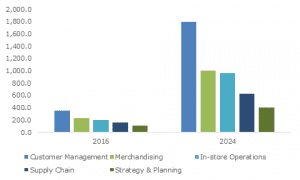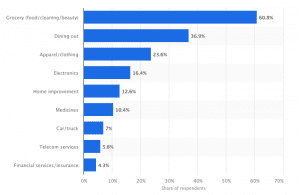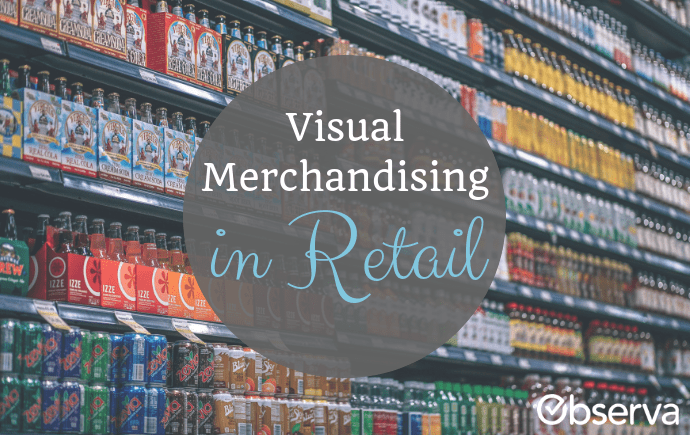Visual Merchandising in Retail
Standing at a shelf that offers endless options is an overwhelming feeling that most shoppers experience during a shopping trip. Merchandising product helps remove that overwhelming confusion for shoppers by attracting their attention to certain products. In return, sales data goes up for the merchandised product, and brand relationships with new buyers are formed.
What is merchandising?
Merchandising is the placement of product and creation of in-store advertisements to produce the best lure for converting shoppers to customers. Merchandising includes the stocking of products and the placement of marketing materials in the store, which help to solve some of the largest issues in retail, such as out of stocks and missing materials.
The technologies for tracking and using merchandising are growing rapidly and expected to continue in the upcoming years.
U.S. Retail Analytics Market Size, By Function, 2016 & 2024 ($Mn) Source: Global Marketing Insights
Source: Global Marketing Insights
What are types of merchandising?
Coupons: For the Saver
Coupons are one of the most common strategies for CPG brands to acquire new customers, and with 61 percent of consumers claiming that the presence of coupons influenced their purchasing decisions, it’s a good merchandising strategy to make.
Influence of coupons on purchase decisions in the United States in 2017, by product category
Source: Statista
Coupon media allocation is evolving as online coupon redemption increases. However, this 27 percent increase of digital coupon distribution is yielding only a 12-point increase in usage. Old-fashioned in-store coupons are frequently a better strategy for brands to use.
While coupons help attract the initial attention of new shoppers, they also simultaneously
- increase the number of new customers,
- increase sales of a specific product,
- increase branding and awareness,
- reward current customers, and
- produce a highly measurable form of marketing.
These strategies highlight the importance of coupons directing consumers toward not just the product but also the brand for potential future purchases. Brand awareness can be a long-standing benefit of coupon usage.
It is extremely important to measure the effectiveness of coupon campaigns so that future campaigns can be optimized. Measuring coupon effectiveness comprises two components: buyers’ usage and the sales team’s execution. Mixing these two KPIs will result in unusable data for future campaigns. Tracking buyers’ usage is typically easy via retailers’ scanning systems, but tracking a sales team’s execution often requires someone outside of the team to physically check the store and ensure the coupons are present and placed correctly.
Facings and Stock: For the Detailed Shopper
A major part of merchandising includes the layout of the shelf, known as the “planogram,” which includes such things as stock levels and number of facings for each product. Not only is it important to have the right amount of stock in the store, but optimizing the number of facings per product can also ensure the products are always in stock on the shelf.
Product Enhancement: For the Aesthetic Shopper
People are attracted to aesthetically pleasing products. A thought from the shopper such as “This looks like it would taste good” goes a long way at the shelf to increase sales. Often, people immediately associate product enhancement with the product’s design, but aesthetic appeal also includes the marketing materials, shelf positioning, and product quality.
Poor product quality appears in many forms, such as ice cream that is covered in ice, damaged packaging, poor lighting, and sales tags blocking the product. These types of product execution often occur at the store level, so it’s important to have eyes in the store on product to spot issues.
Shelf positioning also goes a long way, depending on the target consumer. Companies wanting to sell a sweet cereal to kids should pay for a lower-shelf spot on the planogram to help grab the kids’ attention quicker than would a top-shelf cereal. However, for the “New Year, New Me” parents who want a healthy alternative cereal, an upper-middle shelf slot will typically grab their eyes faster. To remember this concept, a nice little rhyme circles the retail industry: “Eye level is buy level.”
What is the ROI?
Merchandising itself is an investment, and checking its execution is even more costly, but ensuring the right amount of product is in store and displayed correctly is guaranteed to positively affect sales.
Measuring ROI is difficult without a comparison between data on merchandised and non merchandised stores, so before implementing any programs, data should be collected. Moreover, being able to determine if a sale is a direct effect of a specific merchandising strategy is difficult, but repeatedly collecting data before and after making changes is the best way to attempt to attribute changes.
The increase in new technologies, such as data collection on store traffic and SKU performance, allows more confidence in attributing the effect of merchandising. It’s important to collect as much usable information as possible to understand what other variables may be affecting sales data.
Correctly using merchandising ensures that stock is present in the store and on the shelf and attracts shoppers’ attention. Merchandising is extremely important for customer acquisition and brand attraction. With new technologies, it is easier than ever to obtain the necessary data to collect information on store execution and attribute sales to merchandising efforts.

